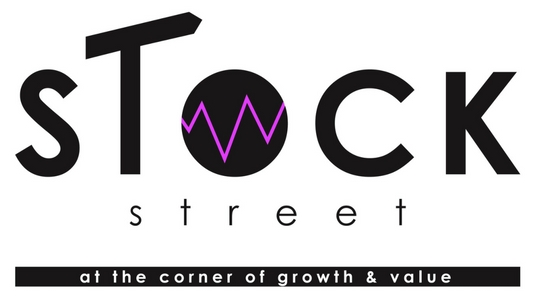Leaning how to invest in the stock market can be head-spinning…but it doesn’t have to be! This article is written for stock market beginners and will help you learn how to invest your money in just 11 simple steps.
You may not even realize this, but if you are reading this page, it means you are taking the initiative to learn how to invest in the stock market. The fact you are taking that initiative makes me admire you, and you should be proud you are learning. So many millennials wait far too long to learn how to invest, and it can haunt their financial for many MANY years.
Stock Street’s goal is to teach beginner investors how to invest, and this particular page is a cornerstone piece of content for this website (it is actually the most important article on the website).
Since my goal for Stock Street is create a medium to help millennial investors learn how to invest, I would LOVE for you to share this article if you find value in it!
On the side of your screen, and at the end of the article, you will see the social share buttons. You can simply click on the buttons and post to social media, or you can even email or text to your friends!
I also invite you to join my Facebook group for beginner and experienced investors. You can click here to view my Facebook group.
And if you are serious about learning how to invest, I created a completely FREE email course. I highly suggest you signup to start learning how to invest in the stock market!
I hope you are excited to learn these 11 simple steps to investing in the stock market. Let’s get to it!
How to invest – step 1 – Find the best investment platform for your needs
To figure out how to get started investing in the stock market, you need to find the best investment platform, or the best investment app, that fits you and your needs.
This is the first step because you can’t start investing if you don’t have a service/company that will give you access to the stock market.
You can break these platforms into robo-advisors and apps, brokers, and fund companies.
Here are some of my favorite platforms for investing.
M1 Finance
As a Millennial, I am all about the investment apps, and, likely, you will also be more inclined to use an investment app than a traditional brokerage company or a fund company.
I personally like M1 Finance, considering it is FREE to buy and sell stocks and ETFs/index funds (free is hard to beat 😉).
M1 Finance isn’t just an app – you can use it on your desktop as well. I like how convenient it is to use the platform as an investment app since we always have our phones on us.
You can click here take a look at M1 Finance.
M1 Finance, in my opinion, is by far the best investment app / robo-advisor platform, and you can read more about the articles I have written regarding the company here: M1 Finance Is Now Free?! No More Fees for the Best Robo-Advisor App and M1 Finance – The First Sexy Robo-Advisor?
TD Ameritrade and Charles Schwab
TD Ameritrade and Charles Schwab fall under the more traditional investment platforms. Unlike M1 Finance which is free, TD Ameritrade and Charles Schwab do charge fees for each purchase and sale of stocks. They may also charge for certain ETFs and index fund investments.
If you are ok with the fees, TD Ameritrade and Schwab both have nice platforms to buy and sell stocks, ETFs, index funds, bonds, and other investment products.
Vanguard and Fidelity
If you want to go directly to the fund company to invest, you can open an account directly with a company like Vanguard or Fidelity. You can invest directly with them instead of going through a traditional brokerage company like Charles Schwab or TD Ameritrade, or a robo-advisor like M1 Finance.
If you go directly to a fund company like Vanguard or Fidelity, you may be limited in what you are able to buy. So, if you are sure you will only be investing in their funds, you may want to go directly to the company.
Of course, you can always invest in Vanguard funds and Fidelity funds through both M1 Finance and TD Ameritrade and Charles Schwab.
The first step along your journey to investing is to decide what company is best for you to start making your first investments. Like I said, I like M1 Finance due to their lack of fees and availability to invest in many different products and companies, but it is up to you what you decide.
Investing in a 401k or 403b for your matching contribution
401k and 403 b investments are popular investment platforms in the United States. These accounts are tax-deferred and are often offered by employers.
When it comes to your 401k or 403b, it is REALLY important that you first get your match if your employer offers one.
Once you reach your match, you can decide if you wish to invest in an IRA, Roth IRA, or a taxable investment account.
All of the companies I mentioned (M1 Finance, TD Ameritrade, Charles Schwab, Vanguard, and Fidelity) offer IRA, Roth IRA, and taxable investment accounts. You can use any of those companies to invest in different types of accounts if you wish.
The most important part is your match – make sure you get that before you invest elsewhere.
How to invest – step 2 – Decide how much money to save and invest
Emergency Fund
Deciding how much money to save and invest for your future is a huge part of investing. The most important part of deciding how much money to save is to make sure you first have cash available before you start investing.
It is important to have an emergency fund before you invest in the stock market because it is possible to have an emergency occur in the future that requires a sizable chunk of money. If that emergency occurs during a recession or a down market, you may not have enough money in your investment account.
Also, you may invest your money in accounts that are difficult to access without paying taxes and/or fees for distribution. For this reason, you should make sure you have cash first before investing.
I wrote this article on emergency funds: 5 Unique Ways to Save an Emergency Fund – AMASS
How much money to save
Once you have your emergency fund, you can start investing money each month. The question of how much you should save each month is complicated. One answer is to save as much as you can! The more the better.
Another answer offered by many experts is to save 20% of your after-tax income. If you save this amount, there is a chance you will save enough for retirement at age 65. But it depends how far behind or ahead you are.
I wrote this article on the subject, but, I must warn you, it is long and detailed! How Much Do I Need to Save For Retirement?
At the very least, do your best to start saving as much as you can spare once you build your emergency fund!
How to invest – step 3 – Dollar cost averaging
When you are a learning how to invest, dollar cost averaging is REALLY important!
Dollar cost averaging is simply adding money to your investments weekly, monthly or even quarterly.
By doing so, you average prices over time, instead of buying all at once – which could be a very peak of a market. You want to average your buying so you don’t end up buying in at the peak. Buy low sell high is the name of the game, not buy high sell low!
If you develop some experience and skill when it comes to investing in individual stocks/securities, you may decide to stop dollar cost averaging. This is because you may be buying stocks you believe are selling at a discount, and therefore you don’t care to average their price over time.
However, when you are a beginner, dollar cost averaging is huge and you need to do it!
I wrote this piece about dollar cost averaging – Should Beginner Investors Dollar Cost Average or Lump Sum Invest a Large Sum of Money?
How to invest – step 4 – Discover your risk tolerance
We have to face the fact that not everyone deals with risk well. If you can’t handle the fluctuations of the stock market, you may not want to keep the majority of your money invested in the stock market.
You may want to hold more stable investments along with your investments in the stock market, like bonds.
Now, as a millennial, you are likely not going to be using your investments for a long time; it may be thirty years before you need your investments.
If that is the case, it is almost always better to own stocks and not bonds.
You just need to ask yourself some hard questions about your ability to handle risk. If you are an emotional person and freak out when stock prices decline, it’s important you include bonds in your investment portfolio.
You can take this investment risk tolerance quiz and it may help you discover how much money you should invest in the stock market, and how much you should invest in more safe investments such as bonds.
How to invest – step 5 – Develop a diversification strategy
We have all heard the saying, “Don’t put all your eggs in one basket”; as you learn how to invest, you will realize this is a really important concept in investing. If you add all of your money into one penny stock, oh my lord are you going to take on a lot of risk!
Adding any money to a penny stock is risky enough if you were to add all your money into something like that, it is foolish.
Adding all your money into a stock like Apple is even foolish. It is not even close to as foolish as if you added it all to a penny stock, but it is still foolish.
You will hear a little more toned down version of diversification from yours truly than many so-called investment experts (I feel like many go a little overboard when it comes to diversification ).
If you own a simple S&P 500 index fund, you average the returns of 500 different companies. That is an extremely diverse investment, and just having an index fund will allow you to diversify your stock market risk.
As we talked about above in regards to your risk tolerance, you may wish to include bonds in the mix of investments. Bonds will diversify your investments and reduce your risk of just having a stock index fund.
Other ways you can diversify your investments include investing in international companies, investing in different size companies (large-cap companies, small-cap companies, etc…) and investing in commodities like gold.
Although, if you end up investing in index funds, I find a simple S&P 500 index fund to be quite adequate.
I have written more about diversification on my investment portfolio page. You can click here to view my portfolio.
How to invest – step 6 – Develop a long-term investment strategy and mindset
Over short periods of time, stocks act crazy. I may even describe them as being “Cray”.
If you try to buy and sell stocks during short periods of times, also known as “trading”, it is going to end badly. Just trust me on this one. Trading is a terrible idea, especially when you are a beginner millennial investor.
I say, “trading”? More like “crayding”!
See what I did there?
When you learn how to invest, you need to start developing a long-term mindset towards investing.
Over long periods of time, the stock market has returned in the 7% – 10% area. Now, during those long-term periods of time, the market acted cray. There were periods of time when you would have been down 45%.
This is why it is SO important to develop a long-term investment strategy.
This will likely consist of you dollar cost averaging (remember that from above) into a diversified investment portfolio and not selling those investments for a very long time. If you keep your investments and don’t sell them for a very long time, you will be way better off.
Think of them as a fine wine that gets better with age.
How to invest – step 7 – Develop realistic goals
Back when I was 12 years old, I made a bet with my cousin that I could get a six-pack within a month. Here I am, over twenty years later, and I still don’t have a six-pack!
Let this be a lesson in developing realistic goals.
Just like I shouldn’t have assumed that doing a few sit-ups every day would give me a ripped beautiful six pack, you shouldn’t think you will instantly make tons of money investing.
You should think to yourself, “How much do investors make?”
Investing is a long-term game. You keep adding money to different stock market investments and those investments will either increase or decrease over short-term periods of time. But, over long-term periods of time, you can expect to gain around 7% – 10% as a passive investor.
If you study investing and become a talented active investor who develops a long-term mindset, it may be ok for you to expect a compound return of a little higher than 10%. But you have to be really good to accomplish this.
If you think about it, at a 10% return, your money will double every 7.2 years. In thirty years, you can double your money over 4 times – this means if you doubled 10k four times, it would be worth $160,000!
Just remember that the answer to the question, How much do investors make? Is not 100% per year. It is closer to 7% per year, and that is over long-term periods of time.
Don’t start as a beginner millennial investor and get bummed with a 1% rate of return in the first six months. Look at what the stock market has done over that six month period of time. If you have significantly underperformed the stock market – if you return 1% and the stock market returns 15% – you may be doing something wrong.
If the stock market is having a tough short-term period of time, just keep investing and over the long term and you should make money.
How to invest – step 8 – Passive investing versus active investing
By the time you get to step 8, you are ready to decide a really important part of investing – passive versus active investing.
If you decide to go the passive investor route, you are making the decision to average the stock market over time. This is a decision predicated on investing in index funds that merely mirror certain indexes.
The other potential way to invest is with active investing. Active investing can mean that you invest in mutual funds. Unlike index funds, mutual funds have a fund manager and the fund manager’s goal is to beat the stock market index. If you are investing with a fund manager, you are attempting to beat an index.
Also, you may decide to pick individual stocks yourself. If you pick individual stocks, you are doing so in an attempt to beat the stock market index as well.
Passive investing versus active investing is a key decision to make for yourself. Once you decide which route you wish to go, you will make your individual investment decisions accordingly.
How to invest – step 9 – Finding stocks and funds
If you decide to become a stock picker, you need to learn how to find stocks.
Stock picking isn’t easy, but it also doesn’t take a genius to figure it out. The more important trait to possess is rational thinking and not being emotional.
At a minimum, you will need to learn important ratios.
For example, the PE ratio is a popular ratio to determine if a stock is a growth stock or a value stock. There are many different ratios people use when analyzing stocks, and you should familiarize yourself with popular ratios for finding stocks.
You should also understand accounting. If you can read financial statements of companies, it will be a really great talent for you to find companies to invest in.
We won’t get into in-depth details on how to find stocks here, just know that step 9 involves a lot of reading, studying, and learning, about strategies and ways to find favorable stocks to buy.
As you learn how to invest your money, if you decide to become a passive investor, you may just decide to own some simple index funds. You may decide to own just an ETF investing in the S&P 500, and there is nothing wrong with this! Investing in individual stocks is not for everyone. Those wishing to just buy an index fund should do quite fine over a long period of time.
You may want to read these articles about fund investing: The Best Free Way to Compare Mutual Funds and Show Index Fund and ETF Comparisons, What the Hell Is an Index Fund? and What the Hell Is a Mutual Fund
How to invest – step 10 – Read quality periodicals and investment books for beginners
Read, read, read. It is so important for you to read as much as you can when you start investing.
Periodicals
I highly suggest you find quality periodicals to read when you begin learning how to invest. You should be reading quality information instead of clickbait articles like, “These 10 Stock will Make You Rich”. Find high-quality periodicals to read on a daily and weekly basis.
I suggest reading both Barron’s and The Wall Street Journal on a weekly basis. I wrote this post about these two periodicals I suggest (it includes deals if you are interested in the periodicals): The 2 Best Financial Publications Every Stock Market Beginner Needs to Read Weekly
Investment books for beginners
There are some great investment books out there, but some of them are a little advanced for beginners.
When it comes to millennial investing, you should choose your investment books based on whether you decide to become an active or passive investor.
If you decide to become a passive investor, one great book is called, The Little Book of Common Sense Investing.
This book is by Jon Bogle, who is the genius behind low-cost Vanguard funds.
If you decide to become an active investor, my personal favorite book for beginner millennial investors is, The Little Book of Value Investing, by Christopher H. Browne.
This is a great book to help introduce you to the concept of value investing – a style of investing I personally fall into.
Another great book you may want to read is The Little Book that Still Beats the Market. This is a great book by a personal favorite investment great, Joel Greenblatt. Joel Greenblatt is a hedge fund manager and teacher at Columbia University. He has an amazing track record and is an amazing investor.
These are some of the best books to read about investing for beginner millennial investors. There are MANY more books than these, and you should read anything you can get your hands on.
By the way, I mention some of the best investment books on my stock portfolio page: My Stock Portfolio
How to invest – step 11 – Understand millennial investing mistakes
The final step is to know what not to do!
If you know what not to do, it will benefit you GREATLY.
I wrote an article called 5 mistakes made by beginner millennial investors. It is always important to know what not to do when investing. In my opinion, the five mistakes in the article are some of the biggest mistakes made by many millennial investors.
We touched on many of these, but the five mistakes include:
- “Trading” stocks
- Not thinking of stocks as pieces of businesses
- Not thinking long-term
- Trying to time the market
- Waiting
If you can avoid these five mistakes, I bet you will be WAY better off long term!
Well, that’s it!
When it comes to learning how to invest in the stock market, these steps should help you begin your investment journey.
Like I said above, this is a really important part of my Stock Street, and I would love for you to share this on social media or with your friends and/or family if you found value in this guide. The social share buttons are on the sidebar and at the bottom of the article.
Also, don’t forget to signup for my FREE email course! It consists of one email per day for five days.
You can signup below:
Thanks for reading!
Disclaimer: These are the ideas and opinions of the author. The author is not responsible for the actions of those who read the posts on this blog. Each individual reader has a unique situation and unique needs. This blog is not intended to solve those unique situations of the readers. This blog is not liable for decisions made by the readers of this blog.
You know how websites add a section at the bottom that says, “This post MAY contain affiliate links”? Well, I am not going to be vague like those websites. We all know if they write that sentence, the post includes affiliate links. So, I will tell you straight up that this post DOES include affiliate links. Use them, I will make a little dough (at no extra cost to you). Here is my affiliate link disclaimer if you want to read more: DISCLAIMER


























